- Author: Brenda Dawson
Though growers can earn retail prices at farmers markets, many farmers find their profits challenged by the additional marketing costs required, such as transportation and staff time. But one farmers market has developed a way that it can help farmers sell higher volumes to multiple buyers with just one trip — by serving as a venue for sales to restaurants and wholesale distributors, in addition to individual customers.
The Santa Monica Farmers Market hosts 75-80 farmers every Wednesday and could very well be the nation's largest "wholesale farmers market." Laura Avery, farmers market manager, gave a presentation about sales to chefs and professional produce buyers at the California Small Farm Conference.
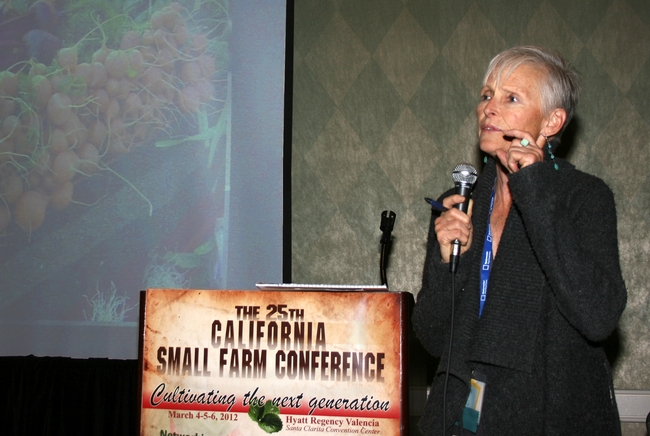
"We allowed it to progress organically," Avery said. "This happened by itself — just people doing what they want to do and getting what they want to get."
She said that a recent survey of professional produce buyers at the market found that they shop for 5-25 customers each week and have been sourcing from the market for 5-15 years. They reported average produce sales of $1,000 to $4,000 each week from the farmers market.
In one of its few concerted efforts to facilitate these sales, the market has designated parking for chefs and produce companies. Avery said some of the trucks will load up and return multiple times over the market's four hours.
A grower's perspective
Jerry Rutiz has been selling to restaurants at the Santa Monica Farmers Market for 29 years. He grows vegetables, berries and flowers on 28 acres in Arroyo Grande and also operates a CSA and farm stand.
"About 70 percent of what we bring to the farmers market is sold to restaurants," Rutiz told conference participants.

He provided some tips for farmers who want to sell to restaurants and develop relationships with chefs.
"Ask the chef what he wants or can't get," Rutiz said. "Don't expect to sell cabbage or white cauliflower to a restaurant, but if you can bring purple, orange or green cauliflower — that can differentiate you and can help differentiate their restaurant from other restaurants."
Also: "Restaurant prices have no consequence with wholesale prices of the moment," he said. "Price is not the biggest criteria, quality and consistency are."
Though Rutiz has found success with chefs, restaurant sales aren't the focus of all farmers at the Santa Monica market.
"We figure about 25 percent [of produce sold at the Wednesday market] is restaurant wholesale," Avery said. "Some farmers like Jerry sell a majority to restaurants, but some sell just to customers and not to restaurants."
Complications

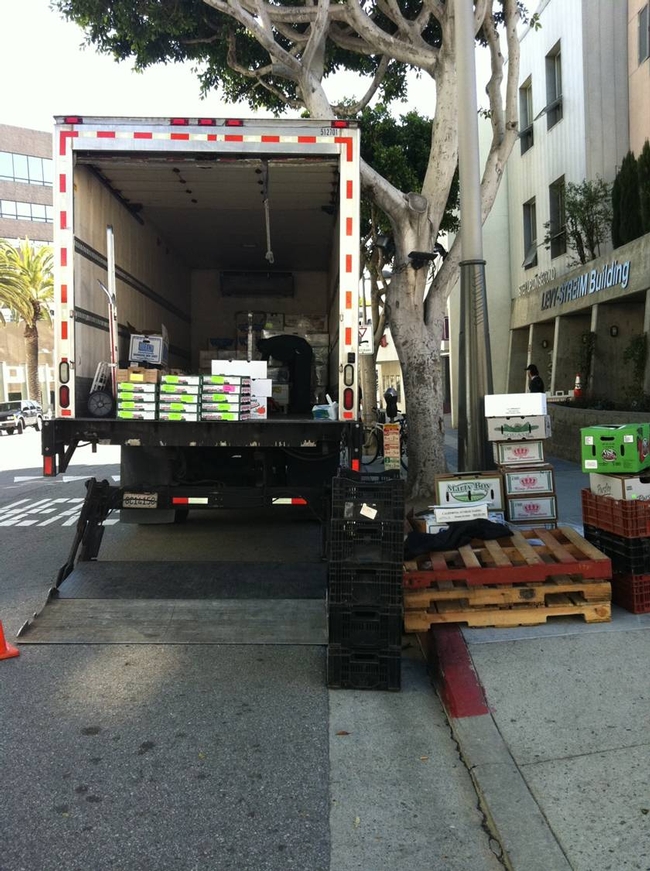
"This is enterprise that takes place on the sidewalk behind the trucks, not in front of the tables where the public buys," Avery said.
Sales to distributors must adhere to wholesale size and pack regulations, though recent state legislation (AB 2168) allows chefs and restaurants to purchase exempt produce directly from farmers.
Rutiz said complications can arise if, for example, a restaurant agrees to buy all of a particular product — the same product that a traditional farmers market customer wants to buy from him.
"The trick is to cover up the produce [that's already sold] or leave it up in the truck. Or have a little stash of strawberries on the side and act like you're doing them a favor," he said.
What it means for buyers
The topic of farmers markets as a venue for wholesale produce buyers came up during another workshop at the conference as well. Karen Beverlin, vice president of specialty sales for FreshPoint, said her company buys from 28-35 farmers every Wednesday in Santa Monica.
"Farmers markets are huge for our company to meet small farmers," Beverlin said. "It's really helped us basically be an aggregator … and meet farmers who we might not have otherwise met."
As a market manager, Avery sees these additional sales at the market as another means of facilitating sales between farmers and consumers.
"The impact of the restaurants and produce companies is we have now established sales levels consistently that are as high as the highest day used to be," Avery said. "The bottom line is we're trying to get the product from the farm to the customer at a good price."
Advice for farmers market managers
For growers and market managers who are interested in developing their farmers markets as a hub for chefs and professional buyers, Avery offered these additional tips:
- Encourage your local media to do a story about a farmer and a chef who shops at the market.
- Understand from chefs which day(s) they need to shop and direct them to the closest market on that day.
- Encourage farmers to produce an availability list that they can email out to chefs on a weekly basis.
- Talk to produce companies about a restaurant that you know might be interested in farmers market produce, and encourage the produce company to drop off samples at the restaurant. This can lead to follow-up orders.
Back to the newsletter: Find more Small Farm News articles from our Vol 1. 2012 edition.
- Author: Brenda Dawson
With the growing popularity of community supported agriculture has come a proliferation of CSA models, with a wide variety of structure, goals, customer interactions and food products. Two different CSAs offered tips to farmers and workshop participants at the California Small Farm Conference.
On the panel were John Fonteyn and Elizabeth Del Negro, who operate Rio Gozo Farm in Ojai on 3.5 leased acres as the sole employees.
Also on the panel was Sarah Nolan, the CSA coordinator for South Central Farmers Cooperative, which farms 85 acres in Buttonwillow and delivers to locations throughout the Los Angeles basin.
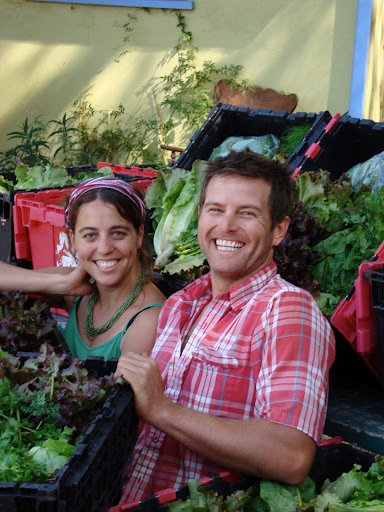
“I think it’s important that we focus on the community aspect of community supported agriculture,” Fonteyn said. “I didn’t want to just put food in boxes and put them in trucks and send them away. I really wanted to live in a community.”
He believes that many CSA member also seek a sense of community and want to be part of building that community themselves. Many of their CSA members volunteer to pack boxes and visit the farm at other times too.
Fonteyn thinks that being likeable as a business person and farmer can go a long way.
“People go to you because they like you,” he said. “It’s really an attachment to us, our goals, our approachability.”
They also make concerted efforts to stay in the public eye.
“We say yes as often as we can,” Del Negro said, listing on-farm dinners, fundraisers, partnering with chefs and entertainers, speaking at events, providing farm tours and cooperating with media members as things they “say yes” to in order to maintain a strong community presence.
Rio Gozo also has an online presence, through a blog, Facebook and Twitter.
“When people search for farms, they want to see beautiful images,” Del Negro said. “When you go on our website, you’ll see deep colors, sharp photos and very few words.”
Retention
Rio Gozo initially offered monthly, seasonal and annual memberships, but have shifted away from offering monthly subscriptions — which has increased their membership retention.
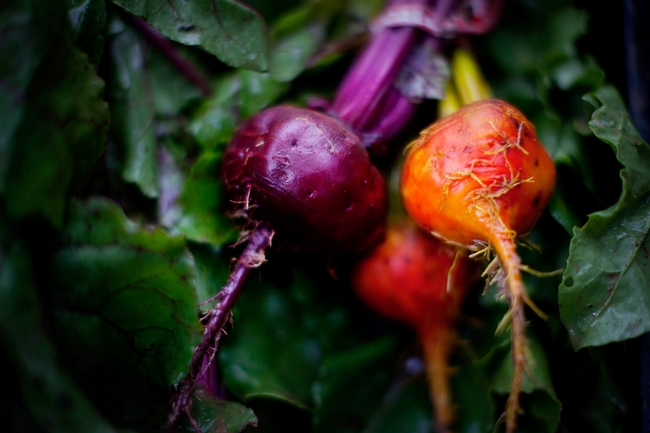
The South Central Farmers Cooperative offers boxes on a one-time basis, in addition to offering monthly and seasonal subscriptions. Though they deliver about 300 boxes per week, they have about 500 customers per year receiving a box at one time or another.
“A lot of your work as a CSA is to throw that broad net out to get more people,” Nolan said. She described a 60 percent attrition rate for CSAs on average as normal.
But, she said, it’s also important to form relationships with customers, so that people who might be inclined to continuing their membership with the CSA do indeed stay on.
Since the South Central Farmers Cooperative also sells at farmers markets, Nolan said they make a point of trying to help customers self-assess whether a CSA is right for them.
“[Consumers] need to figure out — are you a CSA person or a farmers market person?” she said.
Planting
They each offered these general tips about what to grow:
- “Plant as many varieties as possible because CSA members want variety in their boxes, and if you’re not aggregating, then you need to grow it,” Del Negro said.
- “We try to grow as much as possible on our own farm,” Nolan said. “We do partner with other farms and we are very clear with CSA members about who we’re partnering with and what’s going on.”
Regulation
Dave Runsten, of Community Alliance with Family Farmers, spoke up to explain that the California Department of Food and Agriculture is currently working on issues related to direct marketing, including CSAs and how CSAs relate to food safety.
One of the concerns discussed related to food safety for CSAs is controls for “potentially hazardous foods,” which is a regulatory term that can refer to food products that cannot be safely held without temperature controls.
“So the extent that you don’t include potentially hazardous foods in your CSA box, then you won’t be subject to those handling requirements,” Runsten said.
Other concerns related to food safety and CSAs might include the CSA boxes themselves, whether they are cleaned or use a liner, and traceability of product through CSA channels.
Runsten said he maintains an email list of CSA operators in California, as a source for advice and opinions. CAFF is also planning a conference focused on CSAs in January 2013.
Back to the newsletter: Find more Small Farm News articles from our Vol 1. 2012 edition.
- Author: Brenda Dawson
“We really all wanted to be farmers, not truckers,” said farmer Dru Rivers, while discussing the motivations behind the 1981 founding of YoCal Produce Cooperative.
Now as then, the logistics of moving farm-fresh products from fields to markets — not only transportation, but also cold storage, marketing, sales and food safety coordination — can present a challenge for many small-scale farmers.
Collaboration as a way to meet these needs was the topic of the Collaborating to Access New Markets workshop, which brought together about 40 beginning farmers, experienced farmers, entrepreneurs, students and agricultural professionals June 29 in Woodland.
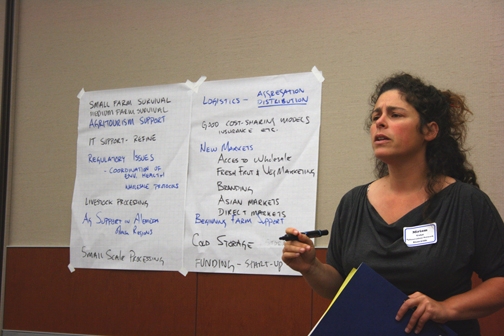
“Small-scale farmers can accomplish things as a group that sometimes they cannot do as individuals,” said Shermain Hardesty, Small Farm Program director and former director of the Rural Cooperatives Center. “We’re not trying to push the cooperative structure specifically, but just to look at ways that farmers might be able to work together in addressing marketing challenges.”
The day included the first complete history of the pioneering YoCal Produce Cooperative as well as a featured speaker from Pennsylvania, Jim Crawford, who discussed the long-term success of the East Coast’s largest organic produce cooperative.
Hardesty highlighted two critical lessons from collaborative ventures discussed that day, specifically: the importance of collaborative members investing financially in their joint operation and the importance of hiring the right staff, particularly managers.
Farmers Jeff Main of Good Humus Produce and Dru Rivers of Full Belly Farm discussed their experiences as founders of YoCal Produce Cooperative.
“We needed to be able to say ‘You need to pay us before we deliver to you again,’” Rivers said. “As one farmer, that doesn’t work, but as 10 farmers that does work.”
Besides strengthening the farmers’ collective voice and sharing transportation, she also highlighted access to new markets and coordinated crop production as important reasons she and others started the cooperative.
Though no longer in operation, YoCal’s decade of collaboration helped increase the viability of many Capay Valley farms and led to many of the group agricultural ventures currently in the region.
Rivers later shared with the audience insights into the current Capay Valley Farm Shop venture, which started as a brick-and-mortar store but has transitioned into a collaborative CSA that serves corporations in the Bay Area. The Capay Valley Farm Shop is not a cooperative, but does serve some marketing needs for participating farmers.
Jim Crawford shared his more than two decades’ worth of experience leading a collaborative marketing service, Tuscarora Organic Growers. This cooperative is owned entirely by member farmers who share the costs of shipping and marketing to retail grocery stores, food co-ops and restaurants in the Washington, D.C., metro area. The cooperative currently works with more than 50 producers to distribute about 100,000 cases of fresh produce and flowers each year.
But when the cooperative held its first meeting in 1988, there were only five growers and they were unable to secure financing for their venture. They decided to try sharing marketing and sales with some extra capacity offered by Crawford’s own New Morning Farm — including cooling space, trucking capacity, an office and a part-time employee.
“One of our strong points [is] our growth has been steady but slow. We never had one of those times of explosive growth,” Crawford explained.
Crawford identified several other aspects of Tuscarora Organic Growers that he believes helped it succeed from its early days, including grower need, a clear and narrow definition, a strong manager, a founding farm that could spearhead support for the co-op, and diverse growers.
The event ended with a brainstorming session, with break-out groups for beginning farmers, experienced farmers and support professionals.
Participant Vonita Murray started her Mariposa Valley Farm this year, selling produce at the Woodland Farmers Market and working to start a CSA. She is still working a part-time job in addition to farming. “I honestly don’t know how I’m going to survive” as a farmer, she said.
By the end of the workshop, Murray had met neighbors and found some new ideas.
“I know a lot of other small farmers with 3 acres or 4 acres, and I know my next step is to talk to them and see how we can share and collaborate,” she said.
Major accomplishments of YoCal Produce Cooperative
- Marketing and trucking: Collaborating on these tasks allowed farmers the time to grow their farms, sell in the wider market, and be able to make a living. The farmers no longer had to farm all day and drive all night or have one partner support the farm with an off-farm job. “It gave us the confidence that we could make it as small farmers without having another job,” said one member.
- Market entry and increased impact: The cooperative provided entry into the wholesale fresh produce market for some growers and increased market power in the wholesale fresh produce market for others. YoCal raised the visibility of smaller farms, increasing the impact of individual brands by co-marketing under the YoCal label. It eased the growth of several farmers who wanted to grow larger. It was a good transition strategy for them.
- Planning to avoid competition: Although not developed as fully as some members would have liked, the group was able to coordinate some multi-farm plantings and grow some crops recommended by distributor partners.
- Grower education: YoCal improved quality, pack and presentation of product at a time when the organic produce industry was in its formative years. Members learned much about cooperative decision making and how to most efficiently spend their time and energy.
- A sense of community: “We got to know farmers we might not have met otherwise,” said one member. YoCal pulled a divergent group of farmers together and gave them a cohesiveness that they probably would never have developed without it. “Major accomplishments for us, as individuals, are that we, as a community of farmers, are still doing cooperative things together,” said another.
- A model: YoCal was one of the first organic marketing cooperatives in modern times.
– excerpt from "YoCal Produce Cooperative:
The Growers’ Story and the Cooperative Principles"
- Author: Brenda Dawson
In case you missed it: A brand-new, revised edition of the Small Farm Handbook is now available from the University of California Agriculture and Natural Resources.
The 2011 edition is a collection of expertise from 31 University of California authors, including farm advisors and specialists. This 188-page book has 11 chapters covering both the business side and the farming side of operating a small-scale farm.
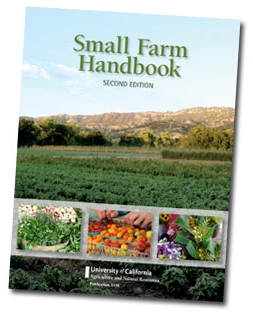
"One thing that’s different about this edition is that we really tried to focus on the business aspects of farming," said Laura Tourte, one of the book's two technical editors and director of UC Cooperative Extension Santa Cruz. "In California we know that a wide diversity of crops can be grown, and the business aspects of it — from managing your finances to marketing your products — are absolutely critical if you want to stay viable and sustainable over the long term."
Chapters include:
- Requirements for Successful Farming
- The Basics
- Enterprise Selection
- Farm and Financial Management
- Marketing and Product Sales
- Labor Management
- Growing Crops
- Postharvest Handling and Safety of Perishable Crops
- Raising Animals
- The Vitality and Viability of Small Farms
- California’s Small Farms: An Overview
The book also includes six profiles of farmers from throughout the state, who produce everything from apples to coffee, lamb to ong choi.
Included among the authors are the UC Small Farm Program's Shermain Hardesty, Richard Molinar, Michael Yang, Aziz Baameur, Mark Gaskell, Desmond Jolly (retired) and Brenda Dawson. Many of the 31 authors are also members of the Small Farm Workgroup.
The 2011 edition of the Small Farm Handbook can be ordered from the UC ANR Catalog for $25, plus applicable tax, shipping and handling.
- Author: Brenda Dawson
May 18 may be just another day, but it will be a busy one for the UC Small Farm Program.
That's because on May 18, the Small Farm Program will be in two places at once — hosting two educational meetings in two different locations in the state.
Before I go any further, here are the details in case you are interested in attending either one:
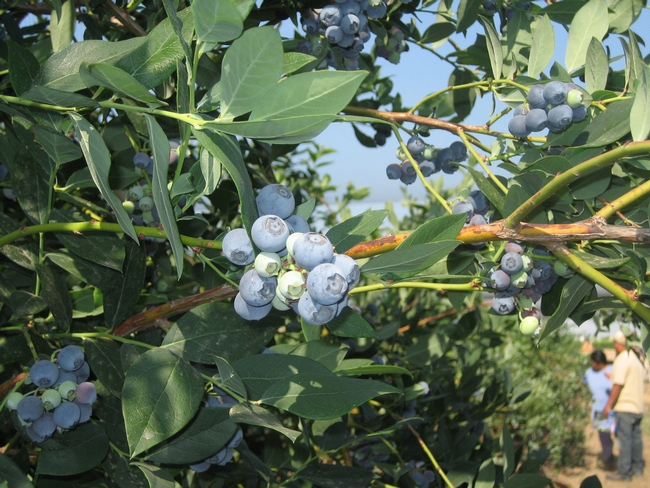
- Blackberry and blueberry field tour
9 a.m. – 3 p.m., Parlier
Visit grower fields and packinghouses, with discussions about field establishment, acidification, irrigation, harvest practices, postharvest handling practices and pruning. (The tour will be followed by a blueberry field day on May 19.) - "Growing Agritourism" workshop
8:30 a.m. – 4:15 p.m., Salinas
Meet with other agritourism operators, tourism experts and government officials to discuss marketing and planning topics. (This is the fifth offering of this workshop, which has already been offered in four other California regions this year.)
(See other small farm-related events on the Small Farm Program calendar.)
At both events, participants will be sharing research, swapping experience and networking, networking, networking.
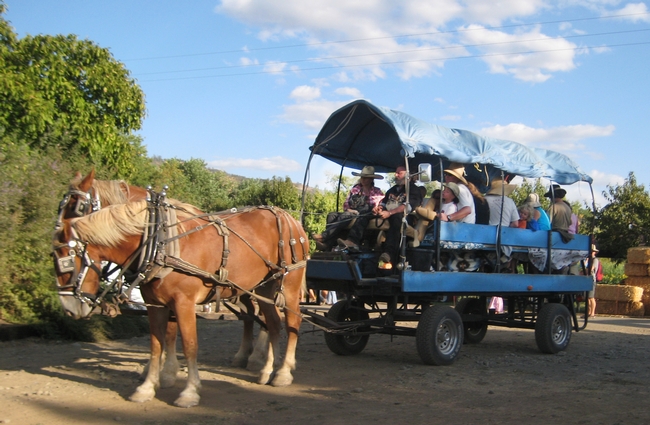
This is a good reminder that many small-scale farmers have to be skilled at both production (growing food) and marketing (selling food), as they are unlikely to have many employees.
When it comes to production, small-scale farmers can differentiate themselves by growing niche specialty crops — like blueberries. In fact, UC Cooperative Extension farm advisors with the Small Farm Program (most notably Manuel Jimenez and Mark Gaskell) have been instrumental in introducing blueberries to California farmers as a niche crop. (Here's more information about growing blueberries.)
In marketing, small-scale farmers can often get a leg up on the competition by connecting directly with consumers — and agritourism is one way to do so. The Small Farm Program has been a leader in California agritourism for more than a decade, with a statewide directory of farms to visit (CalAgTour.org) and education about agritourism for farmers (currently managed by Penny Leff).
Juggling both production and marketing can be a challenge for any farmer — just like being in two places at once.



